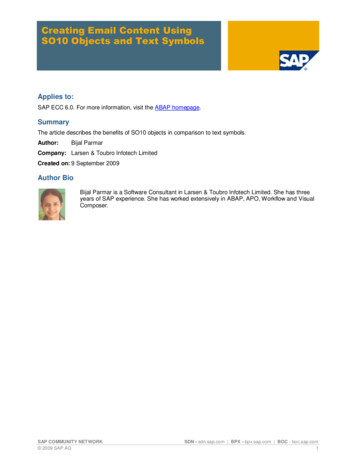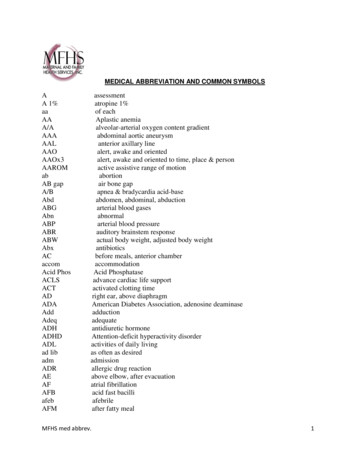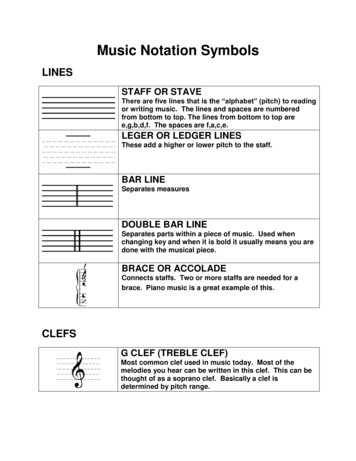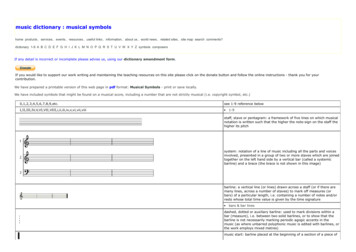
Transcription
Vector Spaces in Physics8/6/2015Chapter 2. The Special Symbols ij and ijk , the EinsteinSummation Convention, and some Group TheoryWorking with vector components and other numbered objects can be made easier (andmore fun) through the use of some special symbols and techniques. We will discuss twosymbols with indices, the Kronecker delta symbol and the Levi-Civita totallyantisymmetric tensor. We will also introduce the use of the Einstein summationconvention.References. Scalars, vectors, the Kronecker delta and the Levi-Civita symbol and theEinstein summation convention are discussed by Lea [2004], pp. 5-17. Or, search theweb. One nice discussion of the Einstein convention can be found athttp://www2.ph.ed.ac.uk/ mevans/mp2h/VTF/lecture05.pdf . You may find other of thelectures at this site helpful, too.A. The Kronecker delta symbol, ij .This symbol has two indices, and is defined as follows: 0, i j (2-1) ij Kronecker delta symbol , i, j 1,2,3 1, i j Here the indices i and j take on the values 1, 2, and 3, appropriate to a space of threecomponent vectors. A similar definition could in fact be used in a space of anydimensionality.We will now introduce new notation for vector components, numbering them ratherthan naming them. [This emphasizes the equivalence of the three dimensions.] We willwrite vector components as Ax (2-2) Ay Ai , i 1,3 A z We also write the unit vectors along the three axes as(2-3)iˆ, ˆj, kˆ eˆi , i 1,3 The definition of vector components in terms of the unit direction vectors is Ai A eˆi , i 1,3The condition that the unit vectors be orthonormal iseˆi eˆ j ij(2-4)(2-5)This one equation is equivalent to nine separate equations: iˆ iˆ 1 , ˆj ˆj 1 , kˆ kˆ 1 ,iˆ ˆj 0 , ˆj iˆ 0 , iˆ kˆ 0 , kˆ iˆ 0 , ˆj kˆ 0 , kˆ ˆj 0 !!! [We have now stoppedwriting "i,j 1,3;" it will be understood from now on that, in a 3-dimensional space, the"free indices" (like i and j above) can take on any value from 1 to 3.]2-1
Vector Spaces in Physics8/6/2015Example: Find the value of ˆj kˆ obtained by using equation (2-5).Solution: We substitute ê2 for ĵ and ê3 for k̂ , givingˆj kˆ eˆ2 eˆ3 23 0 ,correct since ĵ and k̂ are orthogonal.B. The Einstein summation convention. The dot product of two vectors A and B now takes on the form 3A B Ai Bi .(2-6)i 1This is the same dot product as previously defined in equation (1-40), except that AxBxhas been replaced by A1B1 and so on for the other components.Now, when you do a lot of calculations with vector components, you find that the sum ofan index from 1 to 3 occurs over and over again. In fact, occasions where the sum wouldnot be carried out over all three of the directions are hard to imagine. Furthermore, whena sum is carried out, there are almost always two indices which have the same value - theindex i in equation (2-6) above, for example. So, the following practice makes theequations much simpler:The Einstein Summation Convention. In expressions involving vector or tensor indices,whenever two indices are the same (the same symbol), it will be assumed that a sum overthat index from 1 to 3 is to be carried out. This index is referred to as a paired index;paired indices are summed. An index which only occurs once in a term of an expression isreferred to as a free index, and is not summed.This sounds a bit risky, doesn't it? Will you always know when to sum and when not to?It does simplify things, though. The reference to tensor indices means indices onelements of matrices. We will see that this convention is especially well adapted tomatrix multiplication.So, the definition of the dot product is now A B Ai Bi ,(2-7)the same as equation (2-6) except that the summation sign is omitted. The sum is stillcarried out because the index i appears twice, and we have adopted the Einsteinsummation convention.To see how this looks in practice, let's look at the calculation of the x-component of a vector, in our new notation. We will write the vector A , referring to the diagram offigure 1-11, as2-2
Vector Spaces in Physics8/6/2015 A iˆAx ˆjAy kˆAz,(2-8) eˆi Aiwhere in the second line the summation over i {1,2,3} is implicit. Now use thedefinition of the x-component, (2-9)Ax A1 A ê1 .Combining (2-8) and (2-9), we haveA1 A eˆ1 (eˆi Ai ) eˆ1 Ai (eˆi eˆ1 )(2-10) Ai i1 A1In the next to last step we used (2-5), the orthogonality condition for the unit directionvectors.Next we carried out one of the most important operations using the Kronecker deltasymbol, summing over one of its indices. This is also very confusing to someone seeingit for the first time. In the last line of equation (2-10) there is an implied summation overthe index i. We will write out that summation term by term, just this once:Ai i1 A1 11 A2 21 A3 31(2-11)Now refer to (2-1), the definition of the Kronecker delta symbol. What are the values ofthe three delta symbols on the right-hand side of the equation above? Answer: 11 1, 21 0, 31 0. Substituting these values in givesAi i1 A1 11 A2 21 A3 31 A1 1 A2 0 A3 0(2-12) A1What has happened? The index "1" has been transferred from the delta symbol to A.C. The Levi-Civita totally antisymmetric tensor.The Levi-Civita symbol is an object with three vector indices, ijk , i 1, 2,3; j 1, 2,3; k 1, 2,3 Levi-Civita Symbol 1, i, j , k an even permutation of 1, 2,3 (2-13) ijk 1, i, j , k an odd permutation of 1, 2,3 0 otherwise All of its components (all 27 of them) are either equal to 0, -1, or 1. Determining whichis which involves the idea of permutations. The subscripts (i,j,k) represent threenumbers, each of which can be equal to 1, 2, or 3. A permutation of these numbersscrambles them up, and it is a good idea to approach this process systematically. So, weare going to discuss the permutation group.2-3
Vector Spaces in Physics8/6/2015Groups. A group is a mathematical concept, a special kind of set. It is defined asfollows:Definition: A group G is a set of objects A, B, C ,. with multiplication of onemember by another defined, closed under multiplication, and with the additionalproperties:(i) The group contains an element I called the identity, such that, for everyelement A of the group,AI IA A(2-14)(ii) For every element A of the group there is another element B, such thatAB BA I .(2-15)B is said to be the inverse of A:(2-16)A B 1 .(iii) Multiplication must be associative:A BC AB C .(2-17)There is an additional property which only some groups have. If multiplication isindependent of the order in the product, the group is said to be Abelian.Otherwise, the group is non-Abelian.AB BA Abelian group .(2-18)This may seem fairly abstract. But the members of groups used in physics are usuallyoperators, operating on interesting things, such as vectors or members of some othervector space. Right now we are going to consider permutation operators, operating onsets of indices.The Permutation Group. We will start by defining the objects operated on, then theoperators themselves. Consider the numbers 1, 2, and 3, in some order, just like theindices on the Levi-Civita symbol:( a , b, c ) .(2-19)Here each letter represents one of the numbers, and they all three have to be represented.It is pretty easy to convince yourself that the full set of possibilities is (a, b, c) 1, 2,3 , 1,3, 2 , 2,1,3 , 2,3,1 , 3,1, 2 , 3, 2,1 . (2-20)Now the permutation group of the third degree consists of operators which re-arrange thethree numbers as follows: P a, b, c a, b, c P123 I P a, b, c a, c, b P132 P a, b, c b, a, c P213 (2-21) . P a, b, c b, c, a P231 P a , b, c c , a , b P 312 P a, b, c c, b, a P321 2-4
Vector Spaces in Physics8/6/2015The second form of the notation shows where the numbers (1,2,3) would end up underthat permutation. The first entry is the permutation which doesn't change the order,which is evidently the identity for the group. The group consists of just these sixmembersExamples of permutations operating on triplets of indices:P123 2,3,1 2,3,1 P132 2,3,1 2,1,3 P321 2,3,1 1,3, 2 .(2-22)P132 P321 2,3,1 1, 2,3 Do you follow the fourth line? First the permutation P321 is carried out, giving (1,3,2);and then the permutation P132 operates on this result, giving (1,2,3). This brings us to thesubject of multiplication of group elements. This fourth line shows us that the product ofthe given two permutation-group elements is itself a permutation, namelyP132 P321 P312 .(2-23)Try this yourself, and verify thatP312 2,3,1 1, 2,3 .(2-24)From this example, it is pretty clear that the group of six elements given above is closedunder multiplication. There is an identity, the permutation which doesn't change theorder. And it is pretty easy to identify the inverses within the group.Example: Show thatP312 1 P231 .Proof: Try it out on the triplet (a,b,c):p312 a, b, c c, a, b .P231 c, a, b a, b, c The inverse permutation P231 just reverses the effect of P312.There are some simpler permutation operators related to the Pijk, the binary permutationoperators which just interchange a pair of indices, while leaving the third one unchanged. P12 a, b, c b, a, c (2-25) P13 a, b, c c, b, a . P a, b, c a, c, b 23 It is easy to see that the six group members given in equation (2-21) can be written interms of the binary permutation operators:2-5
Vector Spaces in Physics8/6/2015 P123 I P12 2 P132 P232 P132 P23 P213 P12 . P231 P12 P13 P312 P13 P12 P321 P13 (Remember, the right-hand operator in a product operates first.)(2-26)There is a special subset of permutations of a series of objects called the circularpermutations, where the last index comes to the front and the others all move over one(see Figure 2-1).(a,b,c,d,e,f,g) --- (g,a,b,c,d,e,f)Figure 2-1. A circular permutation.For the six objects listed in eq. (2-21), three of them are circular permutations of (1,2,3),namely(2-27) (a, b, c)circular 1, 2,3 , 3,1, 2 , 2,3,1 .Each of these is produced by an even number of binary permutations, and the other threeare produced by an odd number of binary permutations. So, the group divides up intothree "even permutations" and three "odd permutations:" P123 P312 even permutations P231 (2-28) . P213 P odd permutations 132 P321 The Levi-Civita symbol. Now we can finally use the idea of even and odd permutationsto define the Levi-Civita symbol: 1, (ijk) an even permutation of (123) ijk - 1, (ijk) an odd permutation of (123) Levi - Civita Symbol (2-29) 0 otherwise Notice that there are only six non-zero symbols, three equal to 1 and three equal to -1.And any binary permutation of the indices (interchanging two indices) changes the sign.This is the key property in many calculations using the Levi-Civita symbol.Example: Give the values of 312, 213, and 322,2-6
Vector Spaces in Physics8/6/2015Answer: (312) is an even permutation of (123), so 312 1. (213) is obtainedfrom (312) by permuting the first and last numbers, so it must be an oddpermutation, and 213 -1. (322) is not a permutation of (123) at all, so 322 0.Question: Is the permutation group Abelian? What about the subgroup consisting of thethree circular permutations? Answering these questions will be left to the problems.D. The cross product. In the last chapter we found the following result for the cross product of two vectors A and B in terms of their components: A B iˆ( Ay Bz Az By ) ˆj ( Az Bx Ax Bz ) kˆ( A B A B )xyy(1-48)xNotice that there are a lot of permutations built into this definition. In particular, eachterm involves a permutation of (x,y,z), with the first letter indicating the unit vector, thesecond, the component of A, and the third, the component of B. Here is an elegant way ofre-writing this expression using the Levi-Civita symbol: A B i ijk A j Bk(2-30) It may be less than obvious at first glance that (2-30) is the equivalent of (1-48). Firstlet's just examine the index structure of the expression. The left-hand side has a singleunpaired, or free, index, i. This means that it represents any single one of the components of the vector A B - we would say that it gives the i-th component of A B . Now lookat the right-hand side. There is only one free index, and it is i, the same as on the lefthand side. This is the way it has to be. In addition, there are two paired indices, j and k.These have to be summed. If we were not using the Einstein summation convention, this33 expression would read A B i ijk A j Bk . We have decided to follow the j 1k 1Einstein convention and so we will not write the summation signs. However, for anygiven value of i, there are nine terms to evaluate.To see exactly how this works out, let's evaluate the result of (2-30) for i 2. This should give the y-component of A B . Here it is: A B 2 2 jk A j Bk 211 A1 B1 212 A1 B2 213 A1 B3 (2-31) 221 A2 B1 222 A2 B2 223 A2 B3 231 A3 B1 232 A3 B2 233 A3 B3But, most of these terms are equal to zero, because two of the indices on the Levi-Civitasymbol are the same. There are only two non-zero L.-C. symbols: 213 -1, and 231 1. Using these facts, we arrive at the answer2-7
Vector Spaces in Physics8/6/2015 A B (2-32) A1 B3 A3 B1This is the same as the y-component of equation (1-48), if the correct substitutions aremade for numbered instead of lettered components. So, the two versions of the crossproduct agree.2Example: Use the tensor form of the cross product, equation (2-30), to prove that A B B
symbols with indices, the Kronecker delta symbol and the Levi-Civita totally antisymmetric tensor. We will also introduce the use of the Einstein summation convention. References. Scalars, vectors, the Kronecker delta and the Levi-Civita symbol and the Einstein summation convention are discussed by Lea [2004], pp. 5-17. Or, search the web. One nice discussion of the Einstein convention can be .











